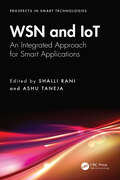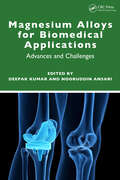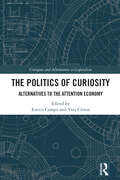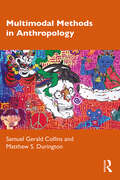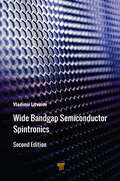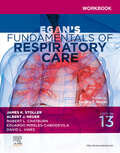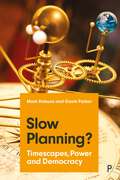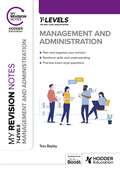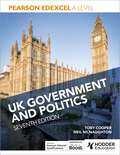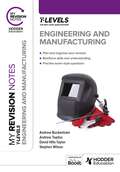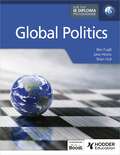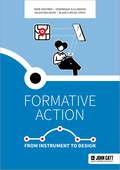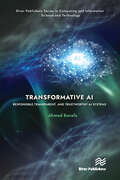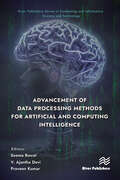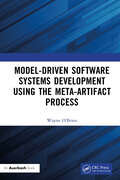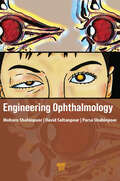- Table View
- List View
WSN and IoT: An Integrated Approach for Smart Applications (Prospects in Smart Technologies)
by Shalli Rani Ashu TanejaNowadays, all of us are connected through a large number of sensor nodes, smart devices, and wireless terminals. For these Internet of Things (IoT) devices to operate seamlessly, the Wireless Sensor Network (WSN) needs to be robust to support huge volumes of data for information exchange, resource optimization, and energy efficiency. This book provides in-depth information about the emerging paradigms of IoT and WSN in new communication scenarios for energy-efficient and reliable information exchange between a large number of sensor nodes and applications.WSN and IoT: An Integrated Approach for Smart Applications discusses how the integration of IoT and WSN enables an efficient communication flow between sensor nodes and wireless terminals and covers the role of machine learning (ML), artificial intelligence (AI), deep learning (DL), and blockchain technologies which give way to intelligent networks. This book presents how technological advancement is beneficial for real-time applications involving a massive number of devices and discusses how the network carries huge amounts of data allowing information to be communicated over the Internet. Intelligent transportation involving connected vehicles and roadside units is highlighted to show how a reality created through the intelligent integration of IoT and WSN is possible. Convergence is discussed and its use in smart healthcare, where only through the intelligent connection of devices can patients be treated or monitored remotely for telemedicine or telesurgery applications. This book also looks at how sustainable development is achieved by the resource control mechanism enabling energy-efficient communication.A wide range of communication paradigms related to smart cities, which includes smart healthcare, smart transportation, smart homes, and intelligent data processing, are covered in the book. It is aimed at academicians, researchers, advanced-level students, and engineers who are interested in the advancements of IoT and WSN for various applications in smart cities.
WSN and IoT: An Integrated Approach for Smart Applications (Prospects in Smart Technologies)
Nowadays, all of us are connected through a large number of sensor nodes, smart devices, and wireless terminals. For these Internet of Things (IoT) devices to operate seamlessly, the Wireless Sensor Network (WSN) needs to be robust to support huge volumes of data for information exchange, resource optimization, and energy efficiency. This book provides in-depth information about the emerging paradigms of IoT and WSN in new communication scenarios for energy-efficient and reliable information exchange between a large number of sensor nodes and applications.WSN and IoT: An Integrated Approach for Smart Applications discusses how the integration of IoT and WSN enables an efficient communication flow between sensor nodes and wireless terminals and covers the role of machine learning (ML), artificial intelligence (AI), deep learning (DL), and blockchain technologies which give way to intelligent networks. This book presents how technological advancement is beneficial for real-time applications involving a massive number of devices and discusses how the network carries huge amounts of data allowing information to be communicated over the Internet. Intelligent transportation involving connected vehicles and roadside units is highlighted to show how a reality created through the intelligent integration of IoT and WSN is possible. Convergence is discussed and its use in smart healthcare, where only through the intelligent connection of devices can patients be treated or monitored remotely for telemedicine or telesurgery applications. This book also looks at how sustainable development is achieved by the resource control mechanism enabling energy-efficient communication.A wide range of communication paradigms related to smart cities, which includes smart healthcare, smart transportation, smart homes, and intelligent data processing, are covered in the book. It is aimed at academicians, researchers, advanced-level students, and engineers who are interested in the advancements of IoT and WSN for various applications in smart cities.
Magnesium Alloys for Biomedical Applications: Advances and Challenges
by Deepak Kumar Nooruddin AnsariMagnesium alloys have enormous potential for use in biomedical implants. Magnesium Alloys for Biomedical Applications delves into recent advances and prospects for implementation and provides scientific insights into current issues posed by Mg alloy materials. It provides an overview of research on their mechanical and tribological characteristics, corrosion tendencies, and biological characteristics, with a particular emphasis on biomedical implants. Details the fundamentals of Mg alloys as well as necessary surface modifications of Mg alloys for biomedical use. Discusses emerging Mg alloys and their composites. Covers mechanical, tribological, and chemical properties, as well as fatigue and corrosion. Highlights emerging manufacturing methods and advancements in new alloy design, composite manufacturing, unique structure design, surface modification, and recyclability. Helps readers identify appropriate Mg-based materials for their applications and select optimal improvement methods. Summarizes current challenges and suggests a roadmap for future research. Aimed at researchers in materials and biomedical engineering, this book explores the many breakthroughs achieved with these materials and where the field should concentrate to ensure the development of safe and reliable Mg alloy-based implants.
Magnesium Alloys for Biomedical Applications: Advances and Challenges
by Deepak Kumar Nooruddin AnsariMagnesium alloys have enormous potential for use in biomedical implants. Magnesium Alloys for Biomedical Applications delves into recent advances and prospects for implementation and provides scientific insights into current issues posed by Mg alloy materials. It provides an overview of research on their mechanical and tribological characteristics, corrosion tendencies, and biological characteristics, with a particular emphasis on biomedical implants. Details the fundamentals of Mg alloys as well as necessary surface modifications of Mg alloys for biomedical use. Discusses emerging Mg alloys and their composites. Covers mechanical, tribological, and chemical properties, as well as fatigue and corrosion. Highlights emerging manufacturing methods and advancements in new alloy design, composite manufacturing, unique structure design, surface modification, and recyclability. Helps readers identify appropriate Mg-based materials for their applications and select optimal improvement methods. Summarizes current challenges and suggests a roadmap for future research. Aimed at researchers in materials and biomedical engineering, this book explores the many breakthroughs achieved with these materials and where the field should concentrate to ensure the development of safe and reliable Mg alloy-based implants.
The Politics of Curiosity: Alternatives to the Attention Economy (ISSN)
by Enrico Campo Yves CittonThrough a variety of studies in the emerging field of attentional studies, this book examines and seeks alternatives to the current attention economy. Bringing together the work of leading scholars of ‘critical attention studies’ to reflect on issues such as techno-politics, socio-politics, and the politics of distraction, it offers a new and multi-disciplinary conceptualization of attention that emphasizes the connections between attention and curiosity, distraction, decoloniality and care. Above all, The Politics of Curiosity asks us to consider the nature and ambivalence of the curious forms of politics that might be taking shape in the shadow of our current attention economy.The “attention economy” has become a household name: we all know our attention is being harvested, commodified and packaged to be sold to advertisers by capitalist platforms. We all complain about it; some of us dream of disconnection; others call to fight back. By focusing on attentional deficits, and by reducing attention to being focused, however, the common view may miss wider stakes, and more promising opportunities. This collective volume provides a new frame of analysis based on three displacements. First, it relocates attentional issues within a triangulation that explores a continuum between attention, distraction and curiosity. Second, it invites us to investigate into the mental infrastructures that socially condition our perceptions and understandings of the world. Third, it points towards emancipatory politics of curiosity to provide alternatives to the attention economy. Contributions range from pedagogy to media theory, via digital studies, epistemology, sociology, political philosophy, literary history, aesthetics, film and dance studies. They gather some of the leading scholars who shaped the study of attention, questioned the values of distraction and explored the potentials of curiosity over the recent years. They extend across nine countries, four continents and seven languages, to provide a multicultural approach to these debates. Together, they help us understand how our current mental infrastructures have taken shape, under specific regimes of power and authority, in a world dominated by capital, colonialism and patriarchy. But they also sketch what can be done to redeploy them around imperatives of respect and care – from a better awareness of our mental biases, online behaviors and bodily movements, to our collective capacity to restructure classroom interactions, to launch alternative digital platforms, to build democratic movements.The first platform for discussion of the politics of attention and curiosity – and an essential point of reference for future debate – this book will appeal to scholars of sociology, politics and psychology.
The Politics of Curiosity: Alternatives to the Attention Economy (ISSN)
Through a variety of studies in the emerging field of attentional studies, this book examines and seeks alternatives to the current attention economy. Bringing together the work of leading scholars of ‘critical attention studies’ to reflect on issues such as techno-politics, socio-politics, and the politics of distraction, it offers a new and multi-disciplinary conceptualization of attention that emphasizes the connections between attention and curiosity, distraction, decoloniality and care. Above all, The Politics of Curiosity asks us to consider the nature and ambivalence of the curious forms of politics that might be taking shape in the shadow of our current attention economy.The “attention economy” has become a household name: we all know our attention is being harvested, commodified and packaged to be sold to advertisers by capitalist platforms. We all complain about it; some of us dream of disconnection; others call to fight back. By focusing on attentional deficits, and by reducing attention to being focused, however, the common view may miss wider stakes, and more promising opportunities. This collective volume provides a new frame of analysis based on three displacements. First, it relocates attentional issues within a triangulation that explores a continuum between attention, distraction and curiosity. Second, it invites us to investigate into the mental infrastructures that socially condition our perceptions and understandings of the world. Third, it points towards emancipatory politics of curiosity to provide alternatives to the attention economy. Contributions range from pedagogy to media theory, via digital studies, epistemology, sociology, political philosophy, literary history, aesthetics, film and dance studies. They gather some of the leading scholars who shaped the study of attention, questioned the values of distraction and explored the potentials of curiosity over the recent years. They extend across nine countries, four continents and seven languages, to provide a multicultural approach to these debates. Together, they help us understand how our current mental infrastructures have taken shape, under specific regimes of power and authority, in a world dominated by capital, colonialism and patriarchy. But they also sketch what can be done to redeploy them around imperatives of respect and care – from a better awareness of our mental biases, online behaviors and bodily movements, to our collective capacity to restructure classroom interactions, to launch alternative digital platforms, to build democratic movements.The first platform for discussion of the politics of attention and curiosity – and an essential point of reference for future debate – this book will appeal to scholars of sociology, politics and psychology.
Multimodal Methods in Anthropology
by Samuel Gerald Collins Matthew S. DuringtonMultimodal Methods in Anthropology develops several goals simultaneously. First, it is an introduction to the ways that multimodality might work for students and practitioners of anthropology, using multiple examples from the authors’ research and from the field. Second, the book carefully examines the ethics of a multimodal project, including the ways in which multimodality challenges and reproduces “digital divides.” Finally, the book is a theoretical introduction that repositions the history of anthropology along axes of multimodality and reframes many of the essential questions in anthropology alongside collaboration and access. Each chapter introduces new methods and techniques, frames the ethical considerations, and contextualizes the method in the work of other anthropologists. Multimodal Methods in Anthropology takes both students and practitioners through historical and contemporary sites of multimodality and introduces the methodological and theoretical challenges of multimodal anthropology in a digital world. Like multimodality itself, readers will come away with new ideas and new perspectives on established ideas, together with the tools to make them part of their practice. It is an ideal text for a variety of methods-based courses in anthropology and qualitative research at both the undergraduate and the graduate level.
Multimodal Methods in Anthropology
by Samuel Gerald Collins Matthew S. DuringtonMultimodal Methods in Anthropology develops several goals simultaneously. First, it is an introduction to the ways that multimodality might work for students and practitioners of anthropology, using multiple examples from the authors’ research and from the field. Second, the book carefully examines the ethics of a multimodal project, including the ways in which multimodality challenges and reproduces “digital divides.” Finally, the book is a theoretical introduction that repositions the history of anthropology along axes of multimodality and reframes many of the essential questions in anthropology alongside collaboration and access. Each chapter introduces new methods and techniques, frames the ethical considerations, and contextualizes the method in the work of other anthropologists. Multimodal Methods in Anthropology takes both students and practitioners through historical and contemporary sites of multimodality and introduces the methodological and theoretical challenges of multimodal anthropology in a digital world. Like multimodality itself, readers will come away with new ideas and new perspectives on established ideas, together with the tools to make them part of their practice. It is an ideal text for a variety of methods-based courses in anthropology and qualitative research at both the undergraduate and the graduate level.
Wide Bandgap Semiconductor Spintronics
by Vladimir LitvinovThis second edition of the book presents spintronic properties of III–V nitride semiconductors. As wide bandgap III-nitride nanostructures are relatively new materials, the book pays particular attention to the difference between zinc-blende GaAs- and wurtzite GaN-based structures where the Rashba spin–orbit interaction plays a crucial role in voltage-controlled spin engineering. It also deals with topological insulators and discusses electrically driven zero-magnetic-field spin-splitting of surface electrons with respect to the specifics of electron-localized spin interaction and voltage-controlled ferromagnetism. It describes the recently identified zero-gap state—an anomalous quantum semimetal. The book comprises calculation of topological indexes in semiconductor and semimetal phases. It compares results that follow from the low-energy model and the Bernevig–Huges–Zhang model, which accounts for the full-Brillouin-zone electron spectrum. It also discusses the fractional quantization of Hall conductance and performs the direct calculation of Chern numbers for the inverted GaN/InN quantum well, determining topological properties by Chern number |C |=2.The book explores and actively discusses semiconductor spintronics and proposes various device implementations along the way. Although writings on this topic appear in the current literature, this book is focused on the materials science side of the question, providing a theoretical background for the most common concepts of spin-electron physics. It covers generic topics in spintronics without entering into device specifics since its aim is to give instructions to be used in solving problems of a general and specific nature. It is intended for graduate students and will serve as an introductory course in this specific field of solid state theory and applications.
Wide Bandgap Semiconductor Spintronics
by Vladimir LitvinovThis second edition of the book presents spintronic properties of III–V nitride semiconductors. As wide bandgap III-nitride nanostructures are relatively new materials, the book pays particular attention to the difference between zinc-blende GaAs- and wurtzite GaN-based structures where the Rashba spin–orbit interaction plays a crucial role in voltage-controlled spin engineering. It also deals with topological insulators and discusses electrically driven zero-magnetic-field spin-splitting of surface electrons with respect to the specifics of electron-localized spin interaction and voltage-controlled ferromagnetism. It describes the recently identified zero-gap state—an anomalous quantum semimetal. The book comprises calculation of topological indexes in semiconductor and semimetal phases. It compares results that follow from the low-energy model and the Bernevig–Huges–Zhang model, which accounts for the full-Brillouin-zone electron spectrum. It also discusses the fractional quantization of Hall conductance and performs the direct calculation of Chern numbers for the inverted GaN/InN quantum well, determining topological properties by Chern number |C |=2.The book explores and actively discusses semiconductor spintronics and proposes various device implementations along the way. Although writings on this topic appear in the current literature, this book is focused on the materials science side of the question, providing a theoretical background for the most common concepts of spin-electron physics. It covers generic topics in spintronics without entering into device specifics since its aim is to give instructions to be used in solving problems of a general and specific nature. It is intended for graduate students and will serve as an introductory course in this specific field of solid state theory and applications.
Workbook for Egan's Fundamentals of Respiratory Care - E-Book: Workbook for Egan's Fundamentals of Respiratory Care - E-Book
by Sandra T HinskiWorkbook for Egan's Fundamentals of Respiratory Care - E-Book
Slow Planning?: Timescapes, Power and Democracy
by Mark Dobson Gavin ParkerA deep exploration on how questions of time and its organisation affect planning practice, this book questions ‘project speed’: where time to think, deliberate and plan has been squeezed. The authors demonstrate the many benefits of slow planning for the key participants, multiple interests and planning system overall.
Slow Planning?: Timescapes, Power and Democracy
by Mark Dobson Gavin ParkerA deep exploration on how questions of time and its organisation affect planning practice, this book questions ‘project speed’: where time to think, deliberate and plan has been squeezed. The authors demonstrate the many benefits of slow planning for the key participants, multiple interests and planning system overall.
My Revision Notes: Management and Administration T Level
by Tess BayleyUnlock students' full potential with this revision guide that will guide them through the knowledge and skills they need to succeed in the Management and Administration T Level core exams.With My Revision Notes, students can:- Plan their own revision and focus on the areas they need to revise with key content summaries and revision activities for every topic- Understand key terms they will need for the exam with user-friendly definitions and a glossary- Use the exam tips to clarify key points and avoid making typical mistakes- Test themselves with end-of-topic questions and answers and tick off each topic as they complete it- Get ready for the exam with tips on approaching the paper, and sample exam questions
Pearson Edexcel A Level UK Government and Politics Seventh Edition
by Neil McNaughton Toby CooperBuild subject knowledge, develop critical understanding and help students practise the skills they need to succeed in their study of UK Government and Politics. This fully updated textbook for Pearson Edexcel A level Politics will help students develop, understand and engage in the latest developments in UK Government and Politics. Written by Neil McNaughton and revised by Toby Cooper, this new edition is specially designed to reflect the Pearson Edexcel specification and let students approach complex topics with confidence.- Comprehensively covers Government of the UK and Politics of the UK- Places recent developments in a historical context throughout to show the influence of political history on current events- Builds subject confidence by highlighting key terms and explaining synoptic links between different topics in the specification - Develops analysis and evaluation skills through debates and practice questions - Provides answer guidance for practice questions online at www.hoddereducation.com/EdexcelUKPolitics7E
My Revision Notes: Engineering and Manufacturing T Level
by Andrew Buckenham Andrew Topliss Stephen Wilson David Hills-TaylorUnlock your full potential with this revision guide that will guide you through the knowledge and skills you need to succeed in the Engineering and Manufacturing T Level core exams.- Plan your own revision and focus on the areas you need to revise with key content summaries and revision activities for every topic- Understand key terms you will need for the exam with user-friendly definitions and a glossary- Breakdown and apply scientific and mathematic principles with clear worked examples- Use the exam tips to clarify key points and avoid making typical mistakes- Test yourself with end-of-topic questions and answers and tick off each topic as you complete it- Get ready for the exam with tips on approaching the paper, and sample exam questions
Global Politics for the IB Diploma (For the IB Diploma)
by Ben Fugill Jane Hirons Brian HullDeveloped in cooperation with the International Baccalaureate®Trust an experienced team of IB educators to help develop the key skills needed to understand global politics with a range of contemporary case studies, different perspectives on political issues provided throughout and extensive assessment support.- Build analytical skills with engaging content comprising of case studies and pedagogy to write them.- Improve performance with knowledge-checking quizzes at the end of each chapter along with essay writing and exam guidance that includes case studies that can be deployed as examples and evidence for Paper 2 responses.- Build inquiry skills through class discussion questions that foster intercultural understanding, open mindedness and respect.- Integrate Theory of Knowledge into your lessons with TOK links and Inquiries, written by our bestselling TOK author John Sprague, that provide real-world examples, case studies and questions.- Develop ATL skills with a range of engaging activities.- Support EAL students with content and support that is tailored to their needs.This coursebook has been reviewed by Melanie Wilson, Head of Global Politics at UWC Southeast Asia.Contents list How to use this book The case study approachCore: Understanding power and global politics 1 Understanding power and global politics Thematic Studies 2 Development and sustainability 3 Peace and conflict 4 Rights and justice 5 Engagement activity/Project 6 Assessment OnlineGlossaryeBook Interactive case studies
Formative action: From instrument to design
by René Kneyber Dominique Sluijsmans Valentina Devid Blanca Wilde LópezFormative practices can motivate students, enhance their self-regulation, and help find a better balance between education and assessment. However, the successful implementation of formative practices and feedback in lessons begins with a well thought out educational design. In this book, the authors outline the implementation principles to which formative action must adhere to be of practical and substantive significance. They also explain how educators can use feedback more effectively and efficiently, and the essential role of instilling a shared sense of quality. This book is for teachers, educators, leaders, and curriculum developers from primary to higher education who want to successfully integrate formative practices into their daily teaching methods.
Transformative AI: Responsible, Transparent, and Trustworthy AI systems (River Publishers Series in Computing and Information Science and Technology)
by Ahmed BanafaTransformative Artificial Intelligence provides a comprehensive overview of the latest trends, challenges, applications, and opportunities in the field of Artificial Intelligence. The book covers the state of the art in AI research, including machine learning, natural language processing, computer vision, and robotics, and explores how these technologies are transforming various industries and domains, such as healthcare, finance, education, and entertainment.The book also addresses the challenges that come with the widespread adoption of AI, including ethical concerns, bias, and the impact on jobs and society. It provides insights into how to mitigate these challenges and how to design AI systems that are responsible, transparent, and trustworthy.The book offers a forward-looking perspective on the future of AI, exploring the emerging trends and applications that are likely to shape the next decade of AI innovation. It also provides practical guidance for businesses and individuals on how to leverage the power of AI to create new products, services, and opportunities.Overall, the book is an essential read for anyone who wants to stay ahead of the curve in the rapidly evolving field of Artificial Intelligence and understand the impact that this transformative technology will have on our lives in the coming years.
Transformative AI: Responsible, Transparent, and Trustworthy AI systems (River Publishers Series in Computing and Information Science and Technology)
by Ahmed BanafaTransformative Artificial Intelligence provides a comprehensive overview of the latest trends, challenges, applications, and opportunities in the field of Artificial Intelligence. The book covers the state of the art in AI research, including machine learning, natural language processing, computer vision, and robotics, and explores how these technologies are transforming various industries and domains, such as healthcare, finance, education, and entertainment.The book also addresses the challenges that come with the widespread adoption of AI, including ethical concerns, bias, and the impact on jobs and society. It provides insights into how to mitigate these challenges and how to design AI systems that are responsible, transparent, and trustworthy.The book offers a forward-looking perspective on the future of AI, exploring the emerging trends and applications that are likely to shape the next decade of AI innovation. It also provides practical guidance for businesses and individuals on how to leverage the power of AI to create new products, services, and opportunities.Overall, the book is an essential read for anyone who wants to stay ahead of the curve in the rapidly evolving field of Artificial Intelligence and understand the impact that this transformative technology will have on our lives in the coming years.
Advancement of Data Processing Methods for Artificial and Computing Intelligence (River Publishers Series in Computing and Information Science and Technology)
This book emphasizes the applications of advances in data processing methods for Artificial Intelligence in today's fast-changing world, as well as to serve society through research, innovation, and development in this field. This book is applicable to a wide range of data that contribute to data science concerns and can be used to promote research in this high-potential new field. People's perceptions of the world and how they conduct their lives have changed dramatically as a result of technological advancements. The world has been gripped by technology, and the advances that are being made every day are undeniably transforming the planet. In the domains of Big Data, engineering, and data science, this cutting-edge technology is ready to support us.Artificial intelligence (AI) is a current research topic because it can be applied to a wide range of applications and disciplines to solve complicated problems and find optimal solutions. In research, medicine, technology, and the social sciences, the benefits of AI have already been proven. Data science, also known as pattern analytics and mining, is a technique for extracting useful and relevant information from databases, enabling better decision-making and strategy formulation in a range of fields. As a result of the exponential growth of data in recent years, the combined notions of big data and AI have given rise to many study areas, such as scale-up behaviour from classical algorithms. Furthermore, combining numerous AI technologies from other areas (such as vision, security, control, and biology) in order to build efficient and durable systems that interact in the real world is a new problem. Despite recent improvements in fundamental AI technologies, the integration of these skills into larger, trustworthy, transparent, and maintainable systems is still in its development. Both conceptually and practically, there are a number of unanswered issues.
Advancement of Data Processing Methods for Artificial and Computing Intelligence (River Publishers Series in Computing and Information Science and Technology)
by Seema Rawat V. Ajantha Devi Praveen KumarThis book emphasizes the applications of advances in data processing methods for Artificial Intelligence in today's fast-changing world, as well as to serve society through research, innovation, and development in this field. This book is applicable to a wide range of data that contribute to data science concerns and can be used to promote research in this high-potential new field. People's perceptions of the world and how they conduct their lives have changed dramatically as a result of technological advancements. The world has been gripped by technology, and the advances that are being made every day are undeniably transforming the planet. In the domains of Big Data, engineering, and data science, this cutting-edge technology is ready to support us.Artificial intelligence (AI) is a current research topic because it can be applied to a wide range of applications and disciplines to solve complicated problems and find optimal solutions. In research, medicine, technology, and the social sciences, the benefits of AI have already been proven. Data science, also known as pattern analytics and mining, is a technique for extracting useful and relevant information from databases, enabling better decision-making and strategy formulation in a range of fields. As a result of the exponential growth of data in recent years, the combined notions of big data and AI have given rise to many study areas, such as scale-up behaviour from classical algorithms. Furthermore, combining numerous AI technologies from other areas (such as vision, security, control, and biology) in order to build efficient and durable systems that interact in the real world is a new problem. Despite recent improvements in fundamental AI technologies, the integration of these skills into larger, trustworthy, transparent, and maintainable systems is still in its development. Both conceptually and practically, there are a number of unanswered issues.
Model-Driven Software Systems Development Using the Meta-Artifact Process
by Wayne O'BrienThe importance of architecture for software systems is widely accepted, but the role of architecture in the overall development process is not so clear. Presenting an architecture-centric process, Model-Driven Software Systems Development Using the Meta-Artifact Process makes the role of architecture clear. At its core, this book is about developing software systems and, more specifically, software code. It describes three major innovations for making software, which are combined with five widely used enabling technologies, to provide a complete, hypothesis-driven software development process known as Meta-Artifact Process (MAP). Having complete requirements is essential for making good software and supports the hypothesis-driven MAP.MAP offers properties, qualities, and capabilities that help stakeholders and developers understand and reason about a domain and target systems of interest. MAP, through the central role of the Meta-Artifact and incorporating the view that a computer program is a hypothesis about the requirements, offers new ways to look at systems and their development, even changing the roles of developers and stakeholders.Recommending agile methods wherever appropriate while supporting the OMG Essence standard and working within an overarching architecture, MAP presents ways to ensure that the requirements are complete and correct. It helps to identify likely points during development to form alternative hypotheses about them. Because MAP requires an underlying software development process, it can provide that clarity to existing processes in which the organization’s developers are already proficient.This book provides concrete examples from two broad but diverse areas—Accounting Information Systems in the commercial area and a military command and control system—to show the wide applicability of MAP in both commercial and defense domains.
Model-Driven Software Systems Development Using the Meta-Artifact Process
by Wayne O'BrienThe importance of architecture for software systems is widely accepted, but the role of architecture in the overall development process is not so clear. Presenting an architecture-centric process, Model-Driven Software Systems Development Using the Meta-Artifact Process makes the role of architecture clear. At its core, this book is about developing software systems and, more specifically, software code. It describes three major innovations for making software, which are combined with five widely used enabling technologies, to provide a complete, hypothesis-driven software development process known as Meta-Artifact Process (MAP). Having complete requirements is essential for making good software and supports the hypothesis-driven MAP.MAP offers properties, qualities, and capabilities that help stakeholders and developers understand and reason about a domain and target systems of interest. MAP, through the central role of the Meta-Artifact and incorporating the view that a computer program is a hypothesis about the requirements, offers new ways to look at systems and their development, even changing the roles of developers and stakeholders.Recommending agile methods wherever appropriate while supporting the OMG Essence standard and working within an overarching architecture, MAP presents ways to ensure that the requirements are complete and correct. It helps to identify likely points during development to form alternative hypotheses about them. Because MAP requires an underlying software development process, it can provide that clarity to existing processes in which the organization’s developers are already proficient.This book provides concrete examples from two broad but diverse areas—Accounting Information Systems in the commercial area and a military command and control system—to show the wide applicability of MAP in both commercial and defense domains.
Engineering Ophthalmology
by Mohsen Shahinpoor David Soltanpour Parsa ShahinpoorThis book is the first of its kind to present the engineering aspects of medical vision ophthalmology. It showcases an array of amazing systems and devices involving biomimetic microrobotics and artificial muscles. It introduces ophthalmology and the fundamentals of vision and discusses robotic surgical systems, implantable micropump assemblies, and synthetic muscle-based diaphragm pump apparatuses. It throws light on the surgical correction of ptosis by polymeric artificial muscles as well as systems and devices for correcting hyperopia, myopia, and presbyopia. The book also reviews synthetic muscle-based multi-powered active contact lenses, surgical correction of human-eye refractive errors using active composite artificial muscle implants, and double-accommodating intraocular accordion lens.
